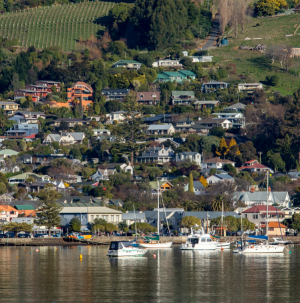Communities in low-lying inland and coastal areas around New Zealand and the world are facing challenges with the impacts of climate change and sea-level rise.
 Here in Ōtautahi-Christchurch and Te Pātaka-o-Rākaihautū Banks Peninsula we are already experiencing the effects of climate change. The future is expected to bring warmer weather across all four seasons, more days of extreme wind, and more intense rainfall.
Here in Ōtautahi-Christchurch and Te Pātaka-o-Rākaihautū Banks Peninsula we are already experiencing the effects of climate change. The future is expected to bring warmer weather across all four seasons, more days of extreme wind, and more intense rainfall.
Climate change is slowly raising the level of the sea. Water expands with heat, so warmer temperatures are causing our oceans to expand. At the same time, these higher temperatures are melting ice sheets and glaciers adding more water to the oceans.
Ōtautahi-Christchurch is more exposed to coastal hazards than any other metropolitan area in New Zealand, including Auckland and Wellington. Across the Ōtautahi-
Christchurch District, approximately 25,000 properties are exposed to coastal hazards risks over the next 120 years. The National Institute of Water and Atmospheric Research (NIWA) estimates that with 1 metre of sea-level rise, the replacement value of buildings is approximately $6.7 billion, the majority of which are residential properties.
As a region, Canterbury has around $1 billion of local government-owned infrastructure exposed to coastal hazards, the majority of which is in Ōtautahi-Christchurch.
The result is a rise in sea level that will not only affect the open coast but also allow high tides and the effects of storms to reach further inland. This means that more land may be affected by coastal flooding, erosion and rising groundwater in the future, and the severity of those impacts would likely be greater.
How the District Plan works now
The Canterbury Earthquake (Christchurch Replacement District Plan) Order in Council 2015 recognised that coastal hazards were not a recovery matter that required an expedited process, so coastal hazard provisions were removed from the 2015 notified District Plan review. Council staff were directed to address this matter separately, and as soon as practicable.
The current District Plan does not define the full extent of areas at risk of coastal hazards and only manages some activities in defined areas. Instead, it relies on the more generic Natural Hazards objective 3.3.6 and policies with activities only managed within areas defined as Flood Management Areas (FMA) and High Flood Hazard Management Areas (HFHMA).
For these areas, there are rules to manage subdivision, development, and land use over and above some legacy provisions from the Christchurch City Plan and Banks Peninsula District Plan. These gaps mean we aren’t effectively managing risks, and development could occur without appropriate controls in place to minimise risk.


 It reflects the approach taken to other hazards in the District Plan; (Areas identified at a higher risk of river flooding that could cause harm are classified as High Hazard Management Areas. Similarly on the Port Hills, a graduated approach is taken with a more restrictive set of rules applying to properties subject to a higher risk of rock fall, cliff collapse and mass movement compared with other areas where there is a lower risk) and is consistent with international risk management best practice (ISO 31000: 2009, Risk Management – Principles and Guidelines).
It reflects the approach taken to other hazards in the District Plan; (Areas identified at a higher risk of river flooding that could cause harm are classified as High Hazard Management Areas. Similarly on the Port Hills, a graduated approach is taken with a more restrictive set of rules applying to properties subject to a higher risk of rock fall, cliff collapse and mass movement compared with other areas where there is a lower risk) and is consistent with international risk management best practice (ISO 31000: 2009, Risk Management – Principles and Guidelines).